Are you interested in learning about the hawks that can be found in Pennsylvania? Look no further!
In this article, we will explore the different species of hawks that inhabit this region. From the agile Sharp-shinned hawk to the majestic Red-tailed hawk, Pennsylvania is home to a diverse range of these fascinating birds of prey.
Prepare to be amazed as we delve into the scientific and objective details of their characteristics and behaviors.
Key Takeaways
- There are several species of hawks found in Pennsylvania, including the Sharp-shinned hawk, Cooper’s hawk, Red-shouldered hawk, Broad-winged hawk, and Red-tailed hawk.
- Conservation efforts are being made to protect hawks in Pennsylvania, including the conservation of rough-legged hawks, ospreys, bald eagles, golden eagles, and other species.
- Hawks in Pennsylvania have specific habitat preferences and hunting behaviors, which vary depending on the species. This includes gray hawks, short-tailed hawks, common black hawks, great black hawks, and roadside hawks.
- The physical characteristics and breeding habits of hawks such as white-tailed hawks, gray hawks, short-tailed hawks, common black hawks, great black hawks, roadside hawks, and white-rumped hawks are also important factors to consider in their conservation.
Sharp-shinned hawk
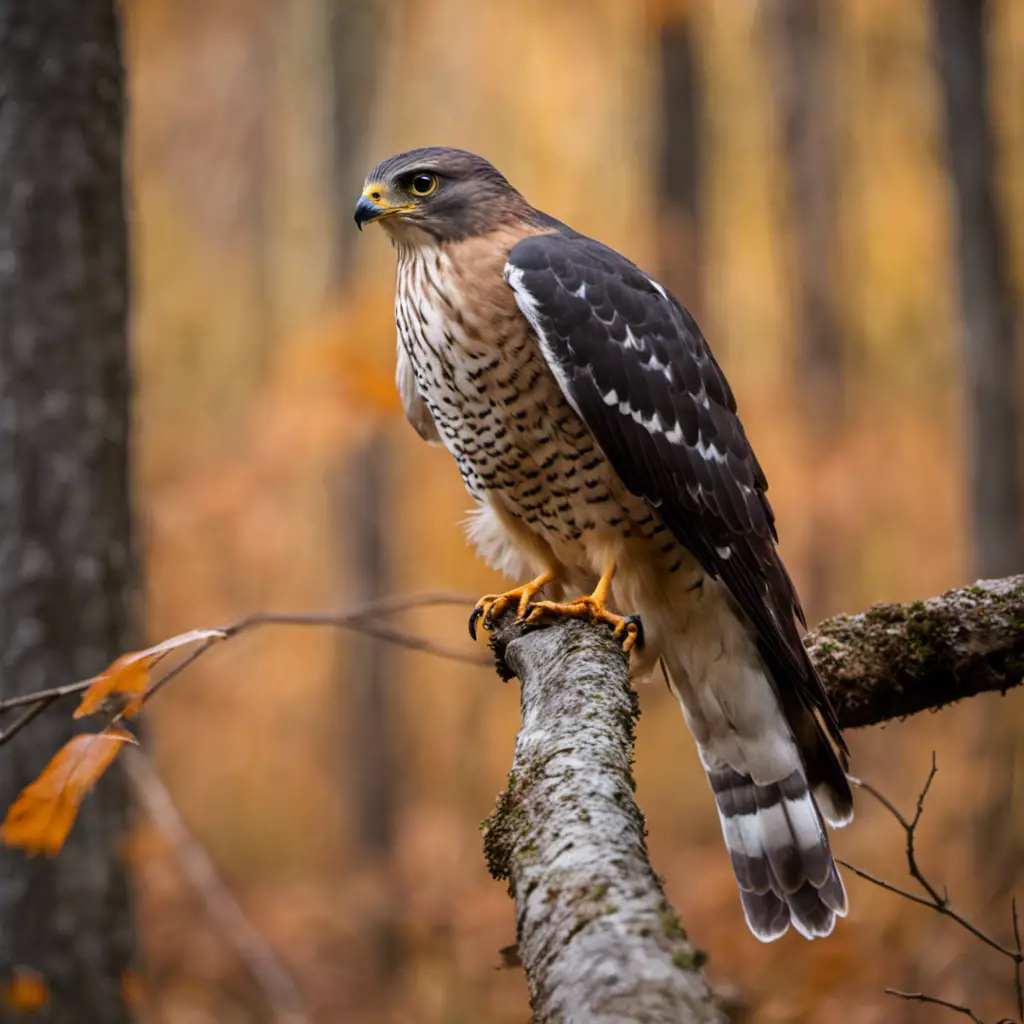
You should watch out for the sharp-shinned hawk because it’s known for its agility and stealth while hunting.
This small hawk, also known as Accipiter striatus, is found throughout North America, including Pennsylvania.
The sharp-shinned hawk prefers forested areas, especially those with dense vegetation, as it provides excellent cover for hunting.
It has a short, rounded wingspan and a long, square-tipped tail, which aids in its quick maneuverability through the trees.
During migration, these hawks can be seen in Pennsylvania as they travel to their breeding grounds in the northern regions.
They’re highly adaptable and can be found in a variety of habitats, including urban areas.
Understanding their habitat preferences and migration patterns can help us appreciate and protect these remarkable birds.
Cooper’s hawk
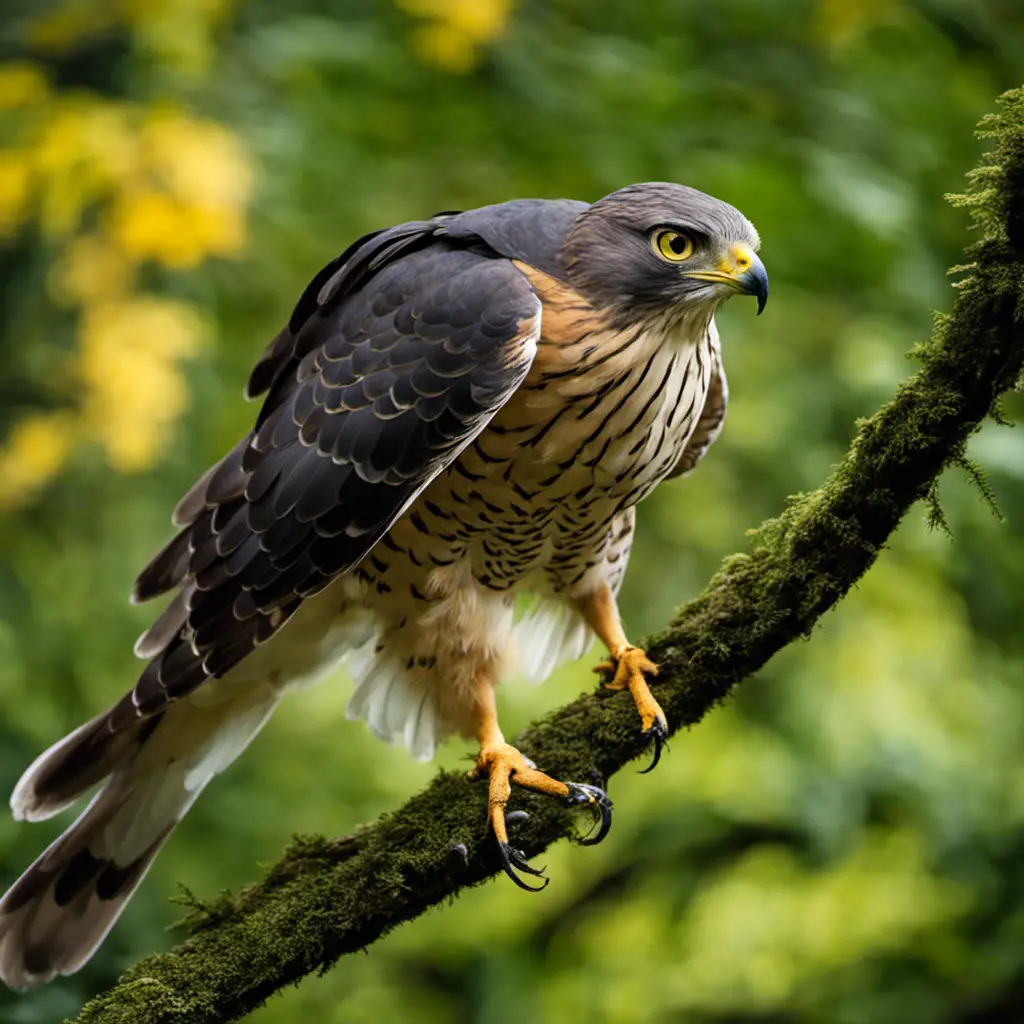
Keep an eye out for the Cooper’s hawk as it tends to blend in with its surroundings while searching for prey. This species, scientifically known as Accipiter cooperii, is a medium-sized hawk that’s commonly found in North America, including Pennsylvania. Here are some interesting facts about the Cooper’s hawk:
Behavioral patterns: The Cooper’s hawk is known for its agile flight and remarkable hunting skills. It often hunts by sitting quietly in a tree and then swiftly flying out to catch its prey, which primarily consists of birds and small mammals.
Habitat preferences: These hawks can be found in a variety of habitats, ranging from dense forests to suburban areas. They prefer areas with tall trees for nesting and hunting.
Size and appearance: Adult Cooper’s hawks have a wingspan of around 3 feet and measure approximately 14-20 inches in length. They’ve a slate gray back, white underparts with fine reddish bars, and a distinctive dark cap on their head.
Breeding behavior: Cooper’s hawks are monogamous and form long-term pair bonds. They build their nests in tall trees using sticks and twigs, lining them with softer materials such as moss and bark.
Migration: While some Cooper’s hawks are year-round residents, others migrate to warmer areas during the winter months. They can cover long distances during migration, often crossing over large bodies of water.
Understanding the behavioral patterns and habitat preferences of the Cooper’s hawk can help us appreciate and protect these fascinating birds in our natural environment.
Red-shouldered hawk
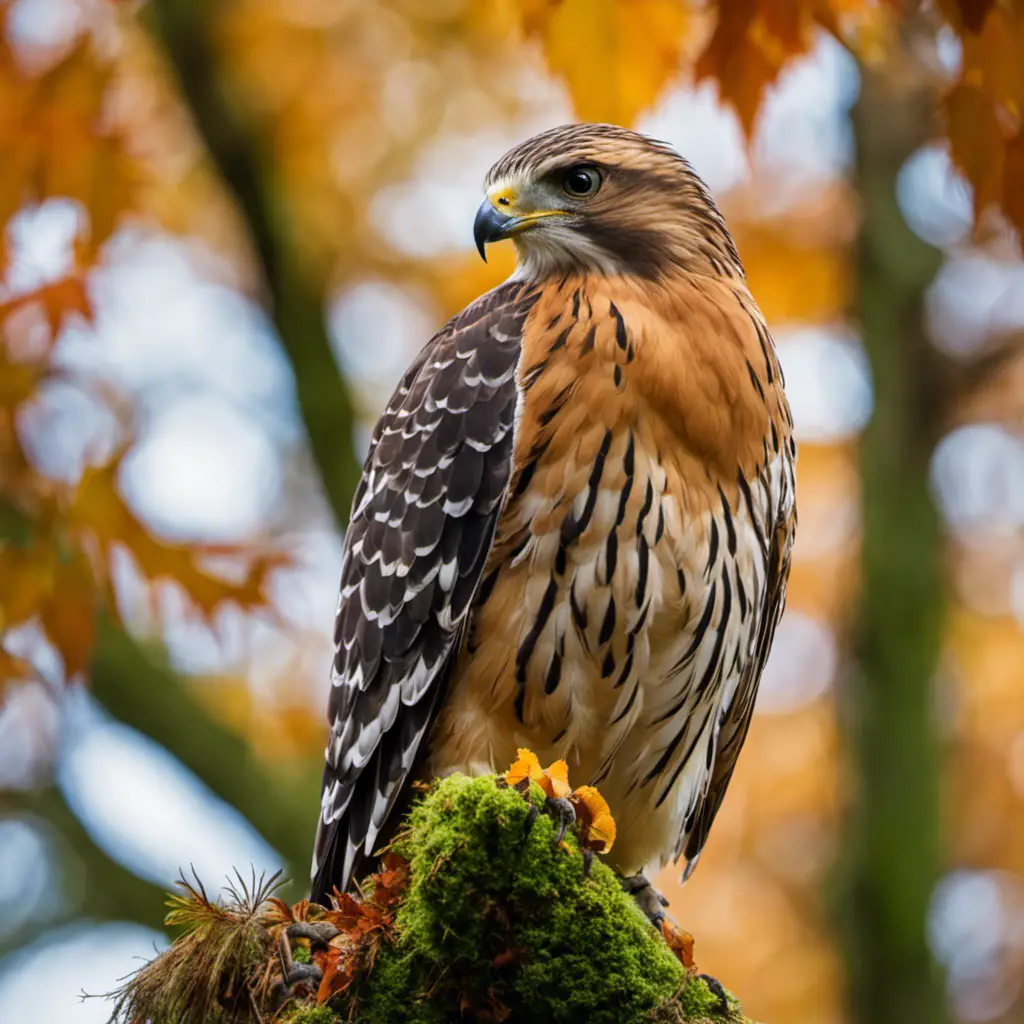
During this time of year, if you’re lucky, you may spot a Red-shouldered hawk soaring through the sky with its distinctive reddish-brown shoulders. Red-shouldered hawks are native to North America and can be found in various habitats, including forests, swamps, and suburban areas. They are known for their striking appearance and impressive hunting skills. Let’s take a closer look at their nesting habits and diet preferences:
Nesting Habits:
| Red-shouldered hawks | |
|---|---|
| 1 | Nest in tall trees |
| 2 | Construct large stick nests |
| 3 | Nests are often reused and added to each year |
| 4 | Clutch size ranges from 2-4 eggs |
| 5 | Incubation period is around 30 days |
Diet Preferences:
| Red-shouldered hawks | |
|---|---|
| 1 | Primarily feed on small mammals, such as rodents |
| 2 | Also consume amphibians, reptiles, and birds |
| 3 | Will occasionally hunt for fish in shallow water |
| 4 | Use their sharp talons to capture prey |
| 5 | Adapt their diet based on seasonal availability of prey |
These fascinating birds play a vital role in maintaining the balance of ecosystems and are a treat to observe in the wild.
Broad-winged hawk
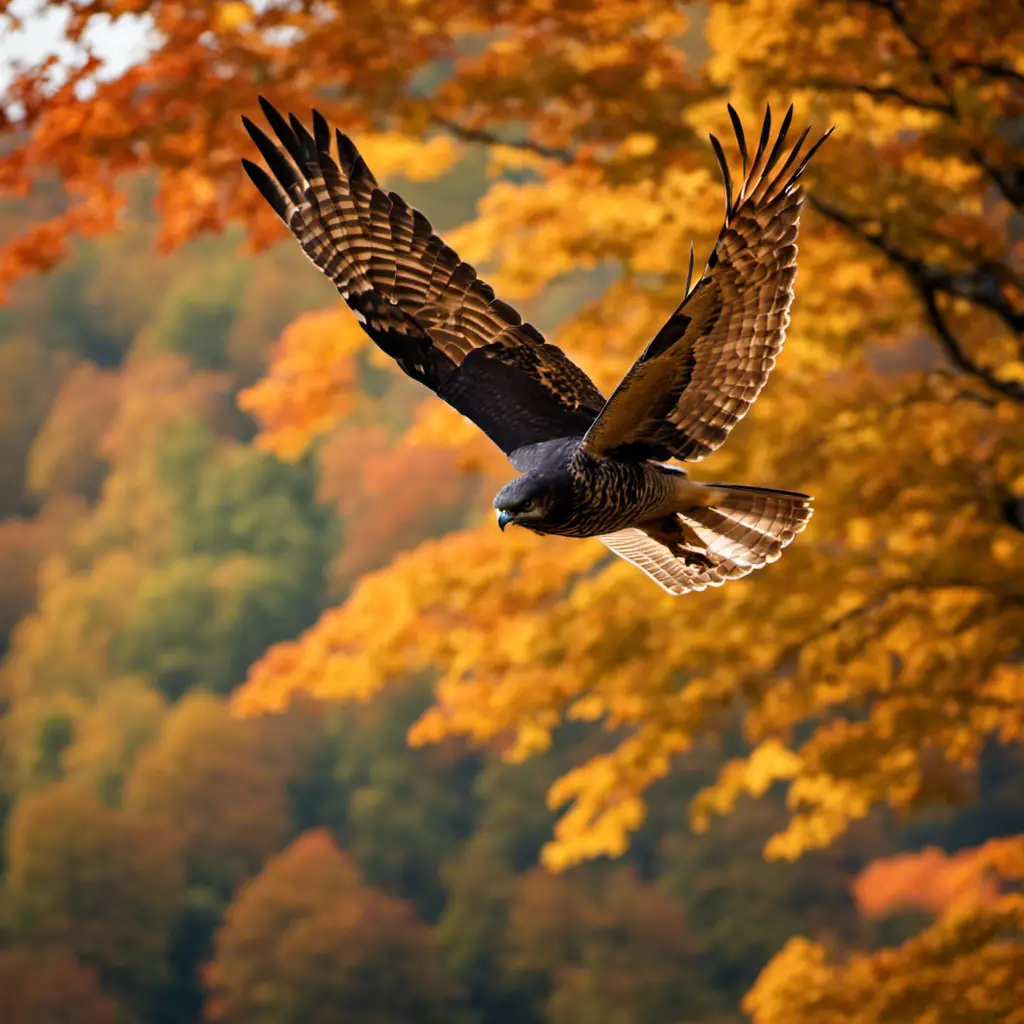
If you’re lucky, you might spot a group of five Broad-winged hawks migrating together during the fall season. These majestic birds, known for their distinctive call and soaring flight, are a common sight in Pennsylvania.
Broad-winged hawks have specific habitat preferences, typically favoring mixed deciduous and coniferous forests with open understories. They’re often found near water sources such as rivers or wetlands.
During migration, Broad-winged hawks form large flocks called ‘kettles’ as they travel south to their wintering grounds in Central and South America. Their migration patterns are highly predictable, with large numbers of hawks passing through Pennsylvania in September.
These birds rely on thermal updrafts to assist in their long-distance flights, conserving energy as they journey thousands of miles. Keep your eyes to the sky, and you may witness the awe-inspiring sight of Broad-winged hawks soaring through the air in their annual migration.
Red-tailed hawk

You can learn about the habitat preferences and migration patterns of the Red-tailed hawk by observing their behavior and studying their flight patterns. Red-tailed hawks are found in various habitats across North America, including forests, grasslands, and deserts. They prefer open areas with scattered trees or perches, which they use for hunting and nesting. Red-tailed hawks are known for their distinctive hunting behavior, where they soar high in the sky and scan the ground for prey. They primarily feed on small mammals, such as mice and rabbits, but they are also opportunistic and will eat birds, reptiles, and even carrion. Conservation efforts for the Red-tailed hawk focus on protecting their habitats, reducing threats from pesticides and power lines, and educating the public about their importance in ecosystems.
| Habitat Preferences | Migration Patterns | Conservation Efforts | Hunting Behavior |
|---|---|---|---|
| Forests | Migrate south in | Protecting habitats, | Soaring high in |
| Grasslands | winter and return | reducing threats | the sky and |
| Deserts | north in summer | from pesticides and | scanning the |
| power lines | ground for prey |
Rough-legged hawk
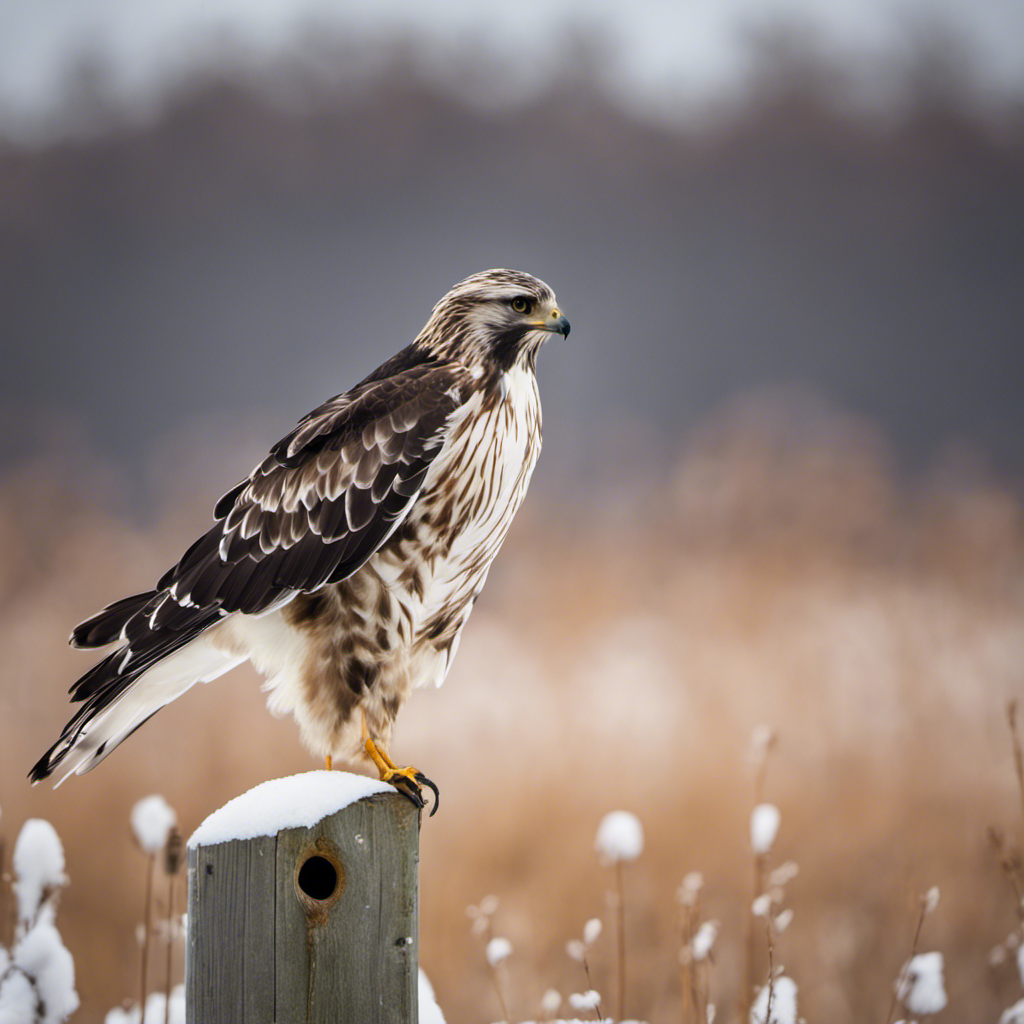
You can easily identify a Rough-legged hawk by its distinctive plumage and its graceful flight, but it’s their adaptability that sets them apart from other hawks.
The Rough-legged hawk, scientific name Buteo lagopus, is a bird of prey that exhibits interesting migration patterns and hunting habits.
Here are some key points to understand about this fascinating species:
Migration Patterns:
Rough-legged hawks are known for their long-distance migrations.
They breed in the Arctic tundra and fly south during the winter months.
Some individuals migrate as far as Central and South America.
Hunting Habits:
Rough-legged hawks primarily feed on small mammals, such as mice, voles, and lemmings.
They have excellent eyesight, allowing them to spot prey from high perches or while hovering.
These hawks employ a combination of soaring and hovering techniques to locate and capture their prey.
Northern goshawk
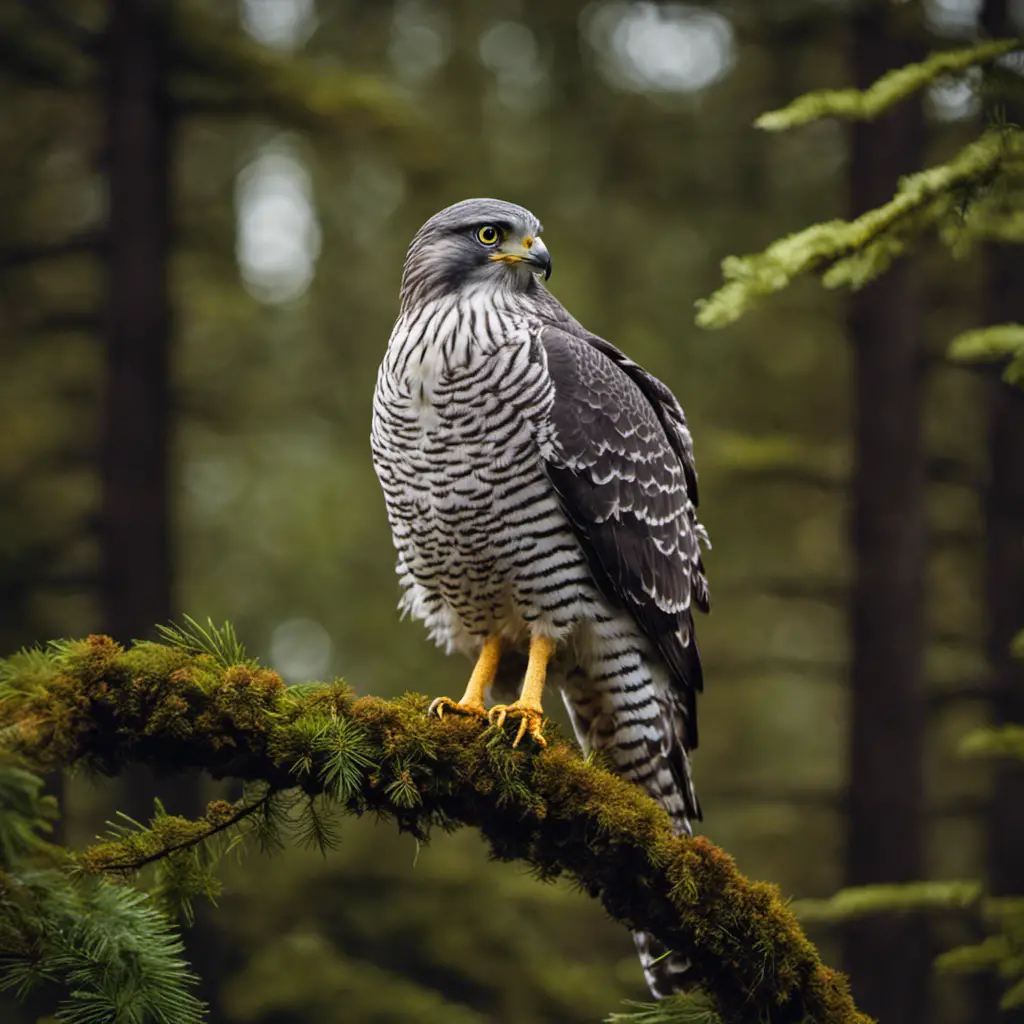
Surely, you have noticed that the Northern goshawk is known for its fierce hunting abilities, and it’s an impressive sight to witness in action.
This magnificent raptor inhabits a variety of forested habitats across the Northern Hemisphere, including North America, Europe, and Asia. In North America, the Northern goshawk can be found in coniferous and mixed coniferous-deciduous forests, where it utilizes the dense foliage for cover during hunting.
However, despite its adaptability to different habitats, the Northern goshawk population has experienced fluctuations in recent years. Various factors, such as habitat loss, climate change, and disturbance of nesting sites, have contributed to these population trends.
Conservation efforts are crucial to ensure the long-term survival of this remarkable species and its vital role in maintaining the ecological balance in its habitat.
Merlin
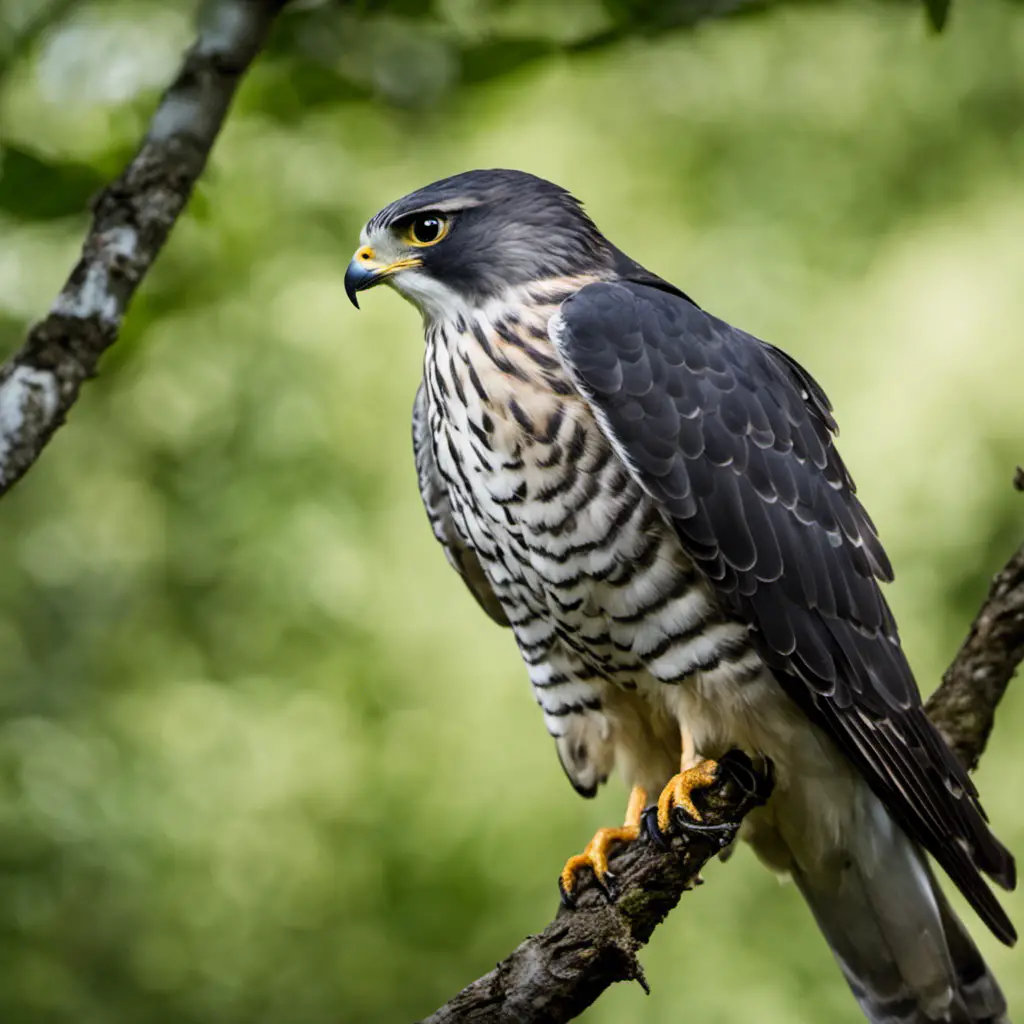
Have you ever seen a Merlin, and do you know how it differs from other falcons? The Merlin (Falco columbarius) is a small and agile falcon that can be found across North America and Europe.
Here are some key characteristics of the Merlin:
Habitat and Behavior: Merlins prefer open habitats such as grasslands, tundra, and marshes. They’re known for their swift flight and impressive hunting skills. Merlins are capable of catching birds on the wing and can even pursue their prey in mid-air acrobatics.
Migration Patterns: Merlins are migratory birds, and their migration patterns vary depending on their breeding range. In North America, they breed in the northern regions and migrate south in the winter. Some Merlins from North America even migrate as far south as South America.
Plumage: The adult male Merlin has a blue-gray back, a rusty-colored breast, and dark streaks on its underparts. The adult female has a brownish back and a heavily streaked underbelly.
Size: Merlins are small falcons, measuring around 25-30 centimeters in length and weighing about 150-250 grams.
Hunting Techniques: Merlins are skilled hunters that primarily feed on small birds. They use their speed and agility to surprise and capture their prey in mid-air, often chasing them in high-speed pursuits.
Osprey
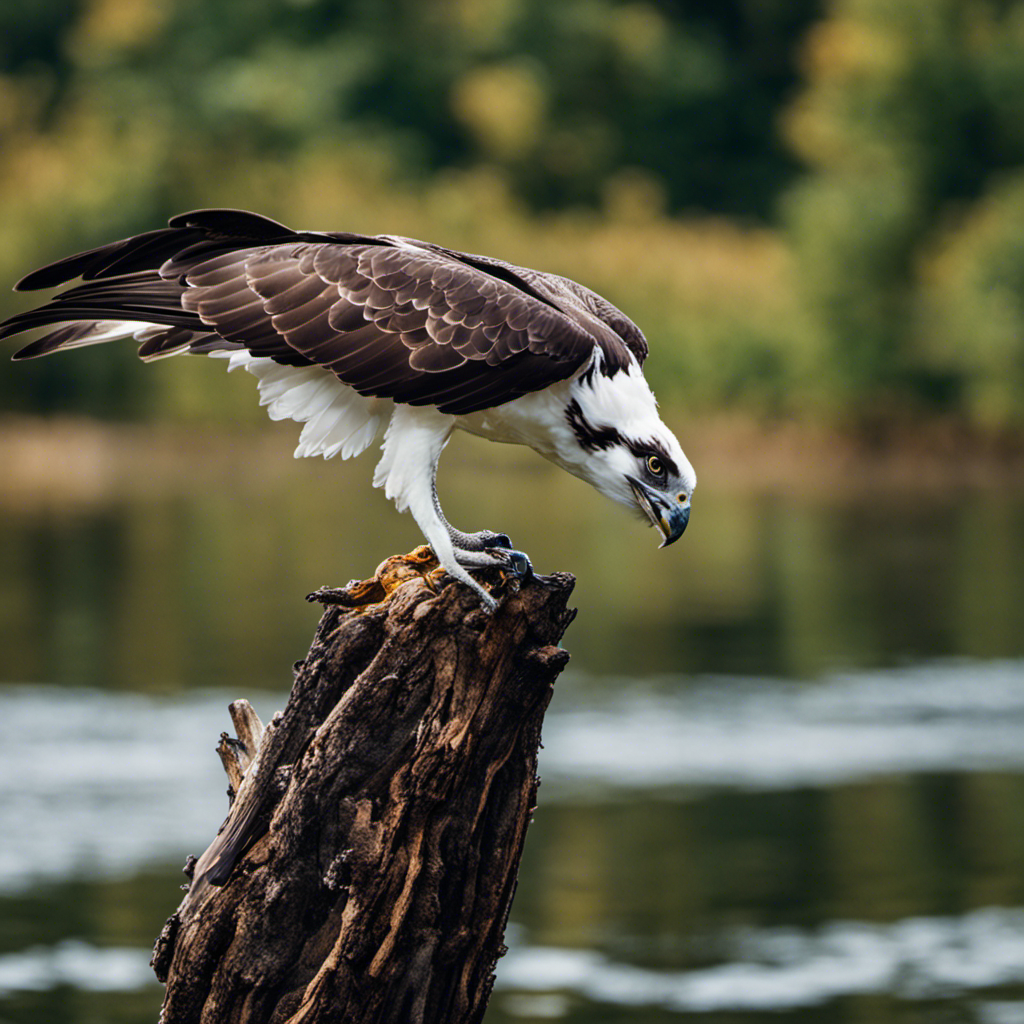
Do you know much about Ospreys, and are you aware that they primarily feed on fish?
Ospreys, scientifically known as Pandion haliaetus, are fascinating birds of prey that have a unique ecology and migration pattern. These magnificent birds can be found in various regions across the world, including North America, Europe, and Asia.
Ospreys are well adapted for catching fish, with their keen eyesight and sharp talons. They’ve a specialized hunting technique, where they hover above the water before diving feet-first to catch their prey.
In terms of migration patterns, ospreys are known to undertake long-distance journeys, traveling thousands of miles between their breeding and wintering grounds.
Conservation efforts play a crucial role in protecting osprey populations, as they face threats such as habitat loss, pollution, and disturbances. Measures such as creating protected areas, monitoring populations, and implementing breeding programs have been implemented to ensure the survival and well-being of these remarkable birds.
Bald eagle
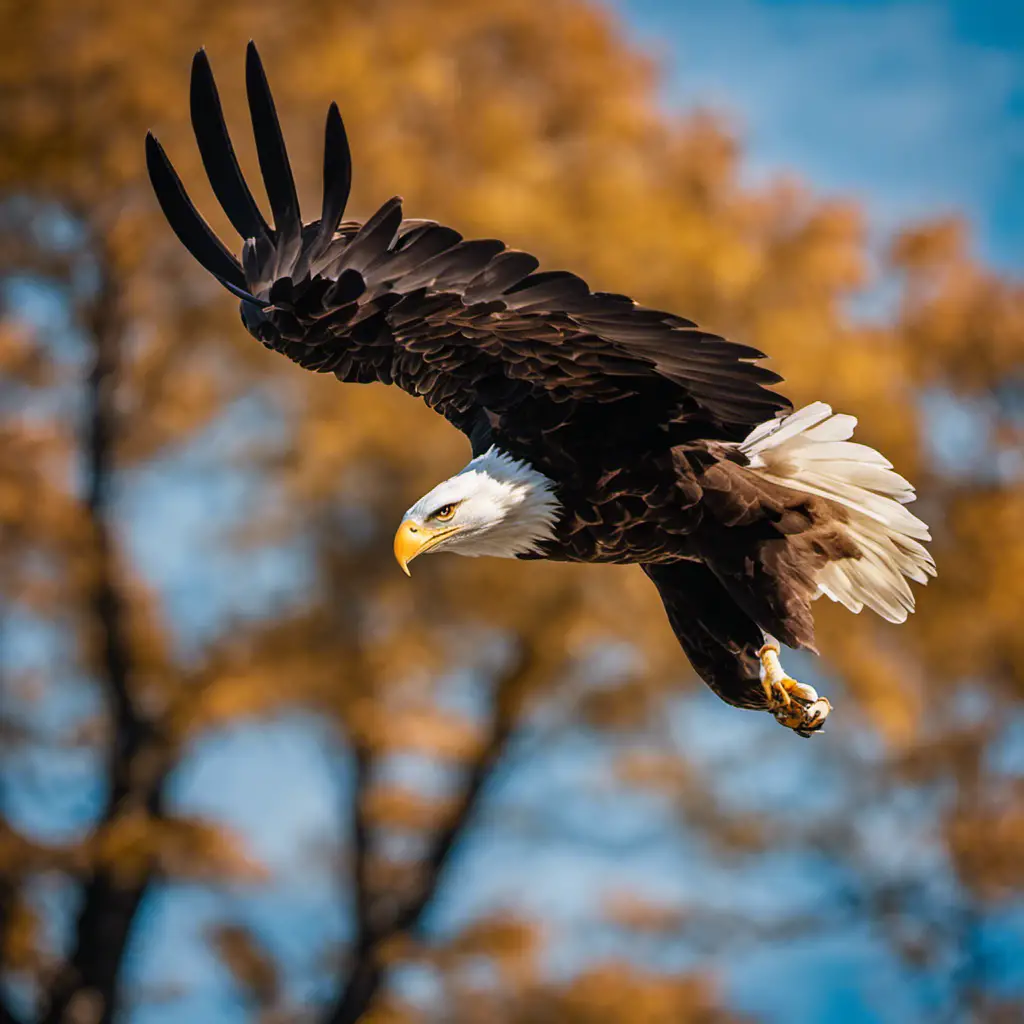
You should admire the majestic beauty of the bald eagle as it soars through the sky. This iconic bird, also known as Haliaeetus leucocephalus, is a symbol of strength and freedom. Bald eagle conservation efforts have been successful in recent years, leading to a steady increase in their population.
Here are five important facts about bald eagles:
Habitat: Bald eagles prefer to nest near large bodies of water, such as lakes, rivers, and coastal areas. They build their nests on tall trees or cliffs, providing a safe vantage point for hunting and breeding.
Behavior: These birds are known for their impressive hunting skills. They primarily feed on fish, but also scavenge for carrion and occasionally prey on small mammals and birds.
Conservation efforts: Due to habitat destruction and hunting, bald eagles were once endangered. However, strict conservation measures, such as the banning of harmful pesticides like DDT, have helped their population recover.
Breeding: Bald eagles form long-term monogamous pairs and typically mate for life. They build large nests, called aeries, which they return to year after year for breeding.
Migration: While some bald eagles are year-round residents, others migrate to warmer areas during the winter months. They can travel long distances and may form communal roosts during migration.
Understanding the behavior and habitat of bald eagles is crucial for their continued conservation and protection. By appreciating their beauty and learning more about them, we can contribute to their successful preservation.
Golden eagle
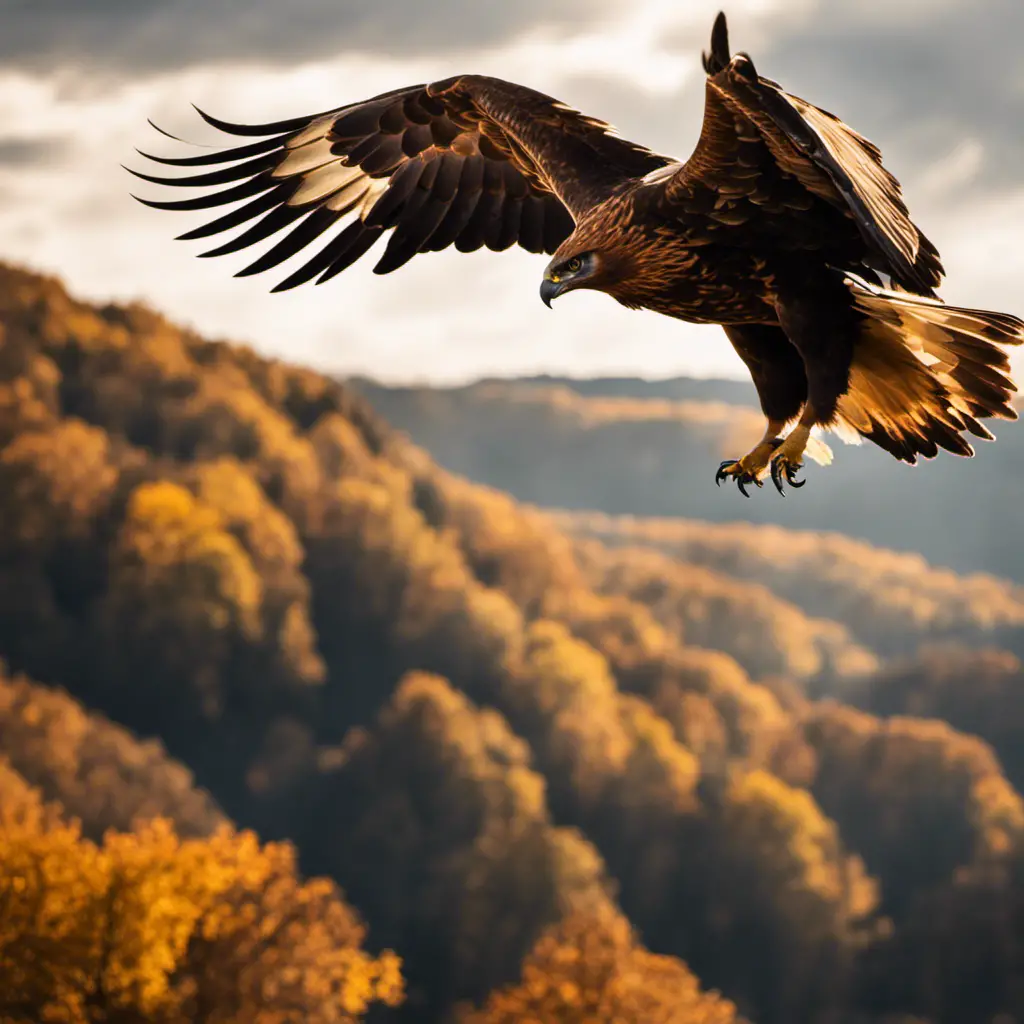
The golden eagle is known for its impressive hunting skills and majestic appearance. This species, scientifically known as Aquila chrysaetos, is one of the largest birds of prey in North America. Golden eagles have a wingspan of up to 7 feet and can reach speeds of 150 miles per hour during their hunting dives. They primarily feed on small mammals, birds, and occasionally reptiles.
Golden eagle conservation efforts are crucial to ensure the survival of this magnificent species. Loss of habitat, illegal hunting, and collisions with wind turbines pose significant threats to their population. Conservation organizations work towards protecting nesting sites and implementing measures to reduce human disturbance during breeding seasons.
Golden eagles are known for their unique nesting habits. They typically build their nests on cliffs or in tall trees, using sticks, grass, and other materials. These nests, known as eyries, are often reused year after year and can reach impressive sizes. Golden eagles are monogamous and mate for life, with breeding pairs returning to the same nesting site each year to raise their young.
Understanding the nesting habits and conservation needs of golden eagles is crucial for ensuring their long-term survival. By protecting their habitats and minimizing human impact, we can contribute to the preservation of this iconic species.
Swainson’s hawk

If you want to learn more about Swainson’s hawk, you should research its migration patterns and habitat preferences.
This species is known for its impressive long-distance migrations, with individuals flying from their breeding grounds in North America all the way to South America for the winter.
Swainson’s hawks prefer open habitats such as grasslands, prairies, and agricultural fields, where they can find ample prey, mainly small mammals and insects.
Conservation efforts for Swainson’s hawk focus on protecting its breeding and wintering habitats, as well as reducing threats such as habitat loss and pesticide use.
Thankfully, population trends for this species have been relatively stable, and their conservation status is currently considered to be of least concern.
Ferruginous hawk

Did you know that the Ferruginous hawk, with its majestic wingspan, is known for its exceptional hunting abilities and adaptability?
The Ferruginous hawk, also known as Buteo regalis, is a large raptor species found in North America. This bird of prey is known for its impressive migration patterns, as it travels long distances between its breeding and wintering grounds.
The Ferruginous hawk primarily breeds in the western parts of the United States and Canada, but during the winter months, it can be found as far south as Mexico. Due to habitat loss and human activities, the Ferruginous hawk population has faced significant declines.
To combat this issue, conservation efforts are being made to protect and restore their habitats, as well as educate the public about the importance of these magnificent birds. By implementing conservation strategies, we can help ensure the survival of the Ferruginous hawk for future generations.
Harris’s hawk
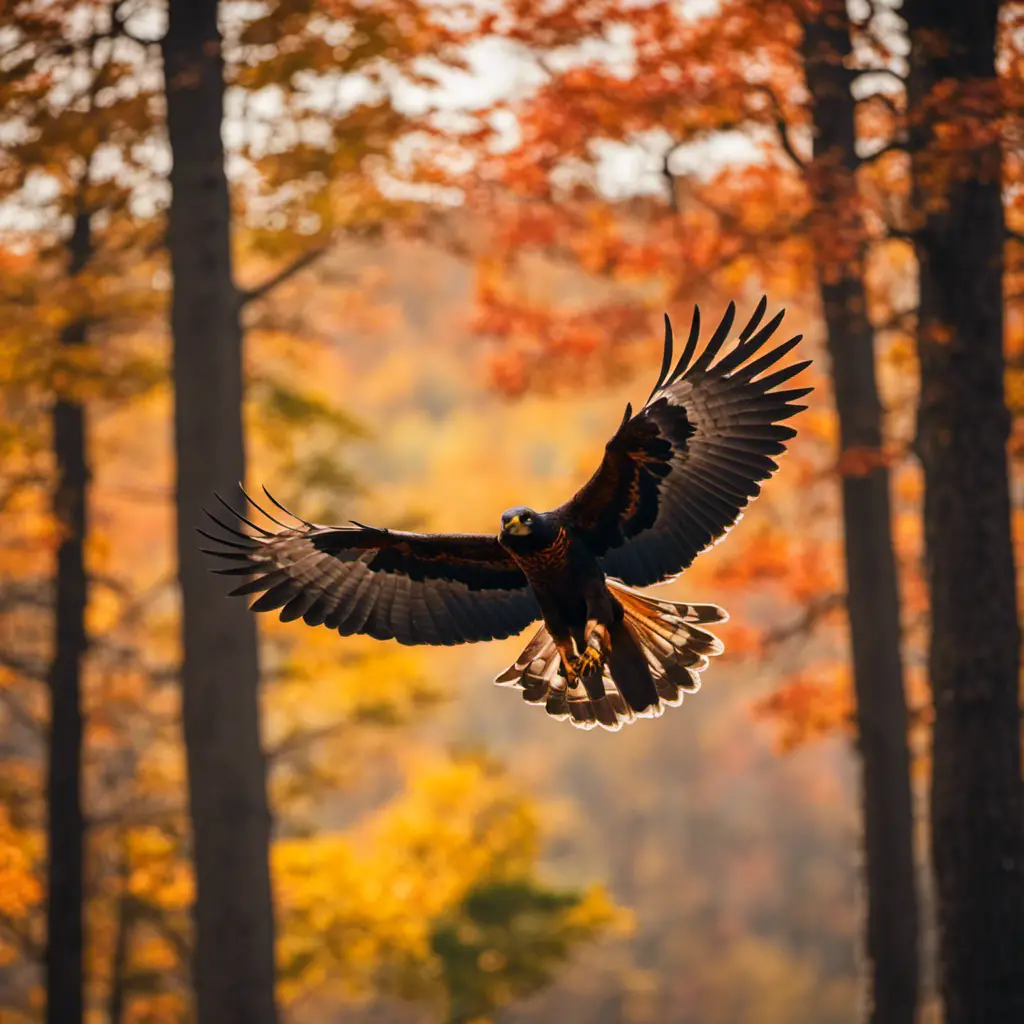
You can learn more about Harris’s hawk by observing its unique hunting behaviors and cooperative nature. This species, also known as Parabuteo unicinctus, is found in the southwestern United States and parts of Mexico.
Here are some interesting facts about the hunting behavior of Harris’s hawk:
Cooperative hunting: Harris’s hawks are known for their cooperative hunting strategies, where they work together in groups to capture prey. This behavior is uncommon among raptors.
Social structure: These hawks have a complex social structure, with dominant and subordinate individuals within their groups. They communicate through vocalizations and body language during hunts.
Versatility in prey: Harris’s hawks have a varied diet, which includes small mammals, birds, reptiles, and even insects. They’re adaptable hunters and can switch their hunting techniques depending on the prey.
Shared parenting: Unlike many other raptor species, Harris’s hawks exhibit shared parenting. Both males and females take part in nest building, incubating eggs, and feeding the young.
Conservation efforts: Due to habitat loss and persecution, Harris’s hawks face some conservation challenges. However, their adaptability to human-altered environments has helped in their survival. Conservation efforts focus on protecting their habitats and raising awareness about these unique hawks.
Zone-tailed hawk

Take a moment to learn about the Zone-tailed hawk, a species currently found in the southwestern United States and parts of Mexico. The Zone-tailed hawk (scientific name: Buteo albonotatus) is a large raptor known for its unique hunting behavior and migration patterns.
| Zone-tailed hawk | Description |
|---|---|
| Size | Approximately 18-24 inches in length, with a wingspan of 45-55 inches |
| Appearance | Adult birds have dark brown plumage, resembling vultures, with a distinctive white band at the base of their tail |
| Migration patterns | Zone-tailed hawks are known to migrate between their breeding grounds in the southwestern United States and their wintering grounds in Mexico |
| Hunting behavior | Unlike other hawks, Zone-tailed hawks are known to mimic the flight patterns of vultures, blending in with their surroundings and surprising their prey |
| Prey | Their diet consists of small mammals, reptiles, birds, and occasionally carrion |
Understanding the migration patterns and hunting behavior of the Zone-tailed hawk provides valuable insights into their ecological role and survival strategies.
White-tailed hawk
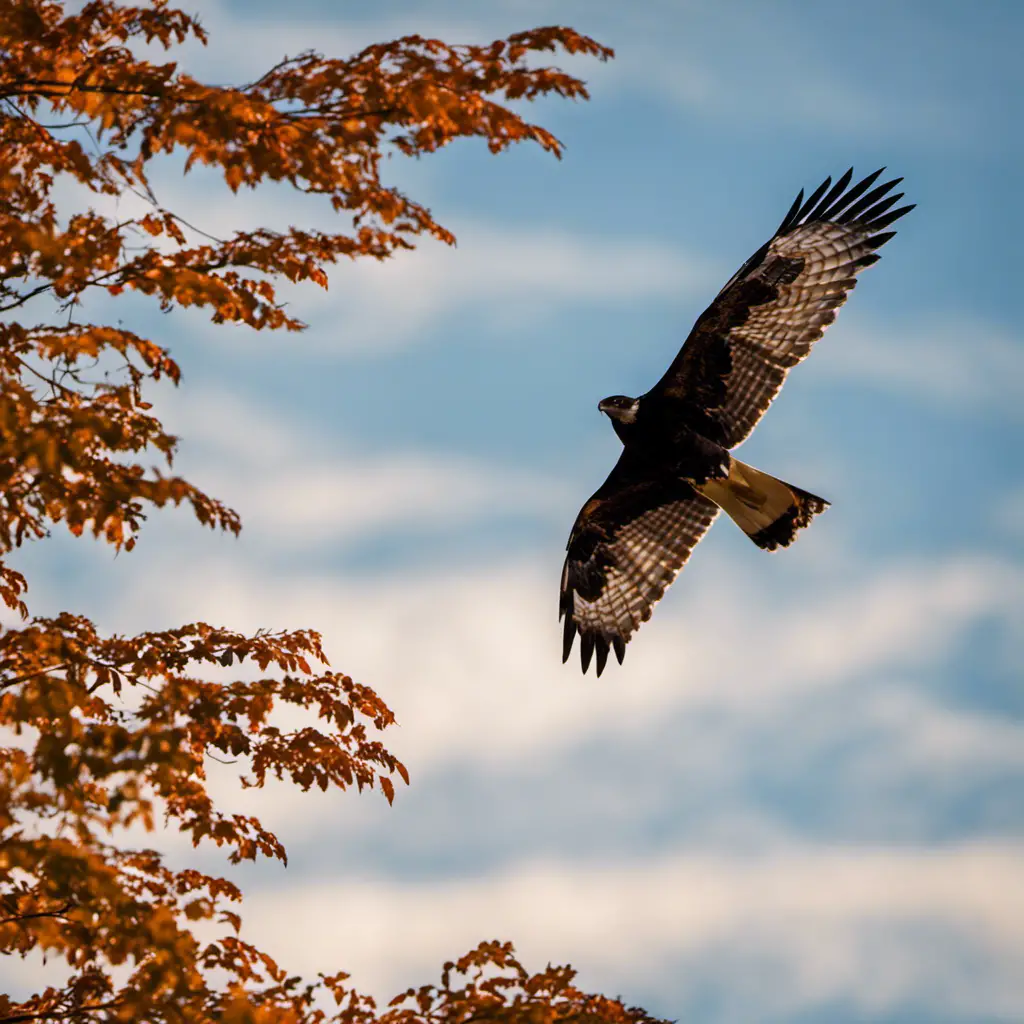
If you’re interested in learning more about hawks, the White-tailed hawk is a species worth exploring. This majestic bird can be found across the southern regions of the United States, including Texas, Arizona, and Florida. Here are some key facts about the White-tailed hawk:
Nesting habits: White-tailed hawks typically build their nests on the tops of trees or cacti, providing a good vantage point for hunting and monitoring their surroundings. They often reuse and expand their nests each breeding season.
Hunting behavior: These hawks primarily feed on small mammals, such as rabbits, mice, and squirrels. They use their keen eyesight to spot prey from high above and then swoop down to catch it. White-tailed hawks are known for their agile flight and impressive hunting skills.
Conservation status: The White-tailed hawk is currently listed as a species of least concern by the International Union for Conservation of Nature (IUCN). However, habitat loss and fragmentation pose potential threats to their population.
Physical characteristics: Adult White-tailed hawks have a distinctive white head, chest, and tail, contrasting with their dark brown wings. They also possess long, slender legs and a hooked beak, which they use to tear apart their prey.
Breeding and reproduction: These hawks usually breed during the spring and summer months. After mating, the female will lay two to three eggs in the nest, which both parents take turns incubating for about a month. Once hatched, the chicks stay in the nest for around two months before fledging.
Gray hawk
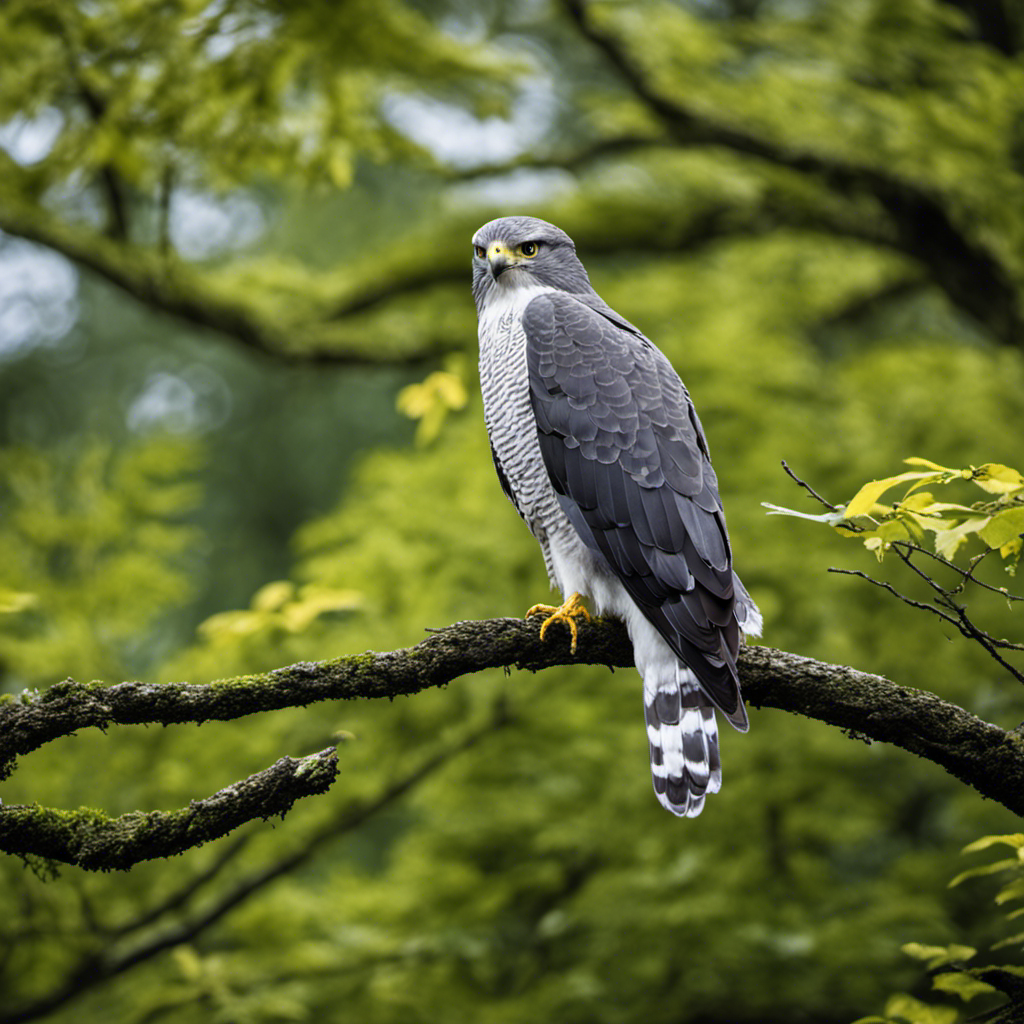
Don’t overlook the Gray hawk, as it’s another intriguing species of hawk found in Pennsylvania.
The Gray hawk, also known as the Mexican hawk, is primarily found in the southwestern United States and parts of Mexico. However, it has been documented to migrate as far as Pennsylvania during the breeding season.
The Gray hawk prefers a variety of habitats, including riparian woodlands, open savannas, and semi-desert areas. They’re known for their unique breeding behavior, as they form monogamous pairs and build large stick nests in trees or cacti. The female Gray hawk typically lays two to four eggs, which are incubated by both parents.
They feed primarily on small mammals, reptiles, and insects. Due to habitat loss and pesticide use, the Gray hawk population has been declining in recent years, making it an important species to study and protect.
Short-tailed hawk
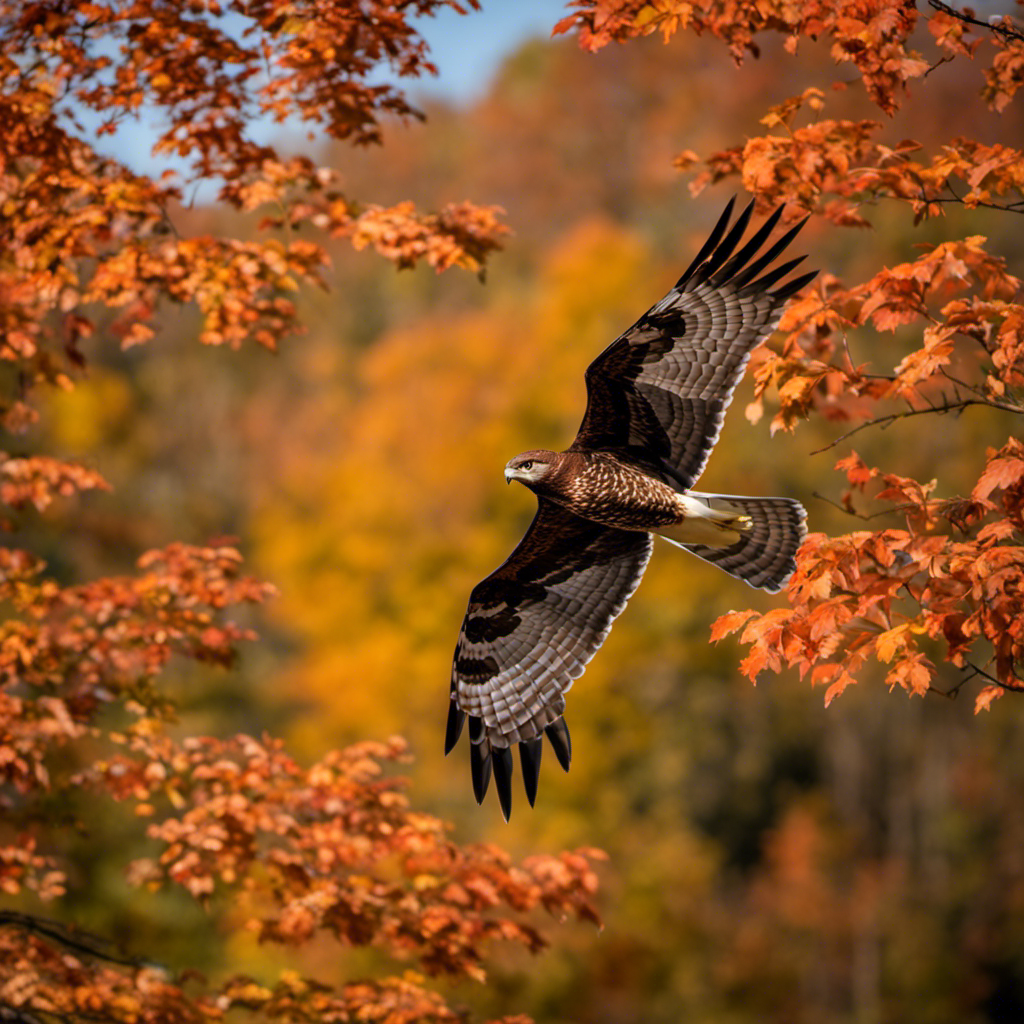
You should definitely consider the Short-tailed hawk, as it’s a fascinating species found in Pennsylvania. This hawk, also known as Buteo brachyurus, is known for its distinctive short tail and broad wingspan.
Here are some key points to understand about the Short-tailed hawk:
Habitat and Behavior: The Short-tailed hawk prefers open woodlands and savannas as its habitat. It’s often seen soaring high in the sky, using its keen eyesight to spot prey such as small mammals and reptiles. They’re known for their agility and impressive hunting skills.
Conservation Efforts: Conservation efforts for the Short-tailed hawk focus on preserving their natural habitats and protecting them from threats such as deforestation and habitat loss. Organizations like the Pennsylvania Audubon Society work towards educating the public and implementing conservation measures to ensure the survival of this species.
Population Trends: The population of Short-tailed hawks in Pennsylvania has remained stable over the years. However, further studies are needed to monitor their population trends and understand any potential threats they may face.
Common black hawk
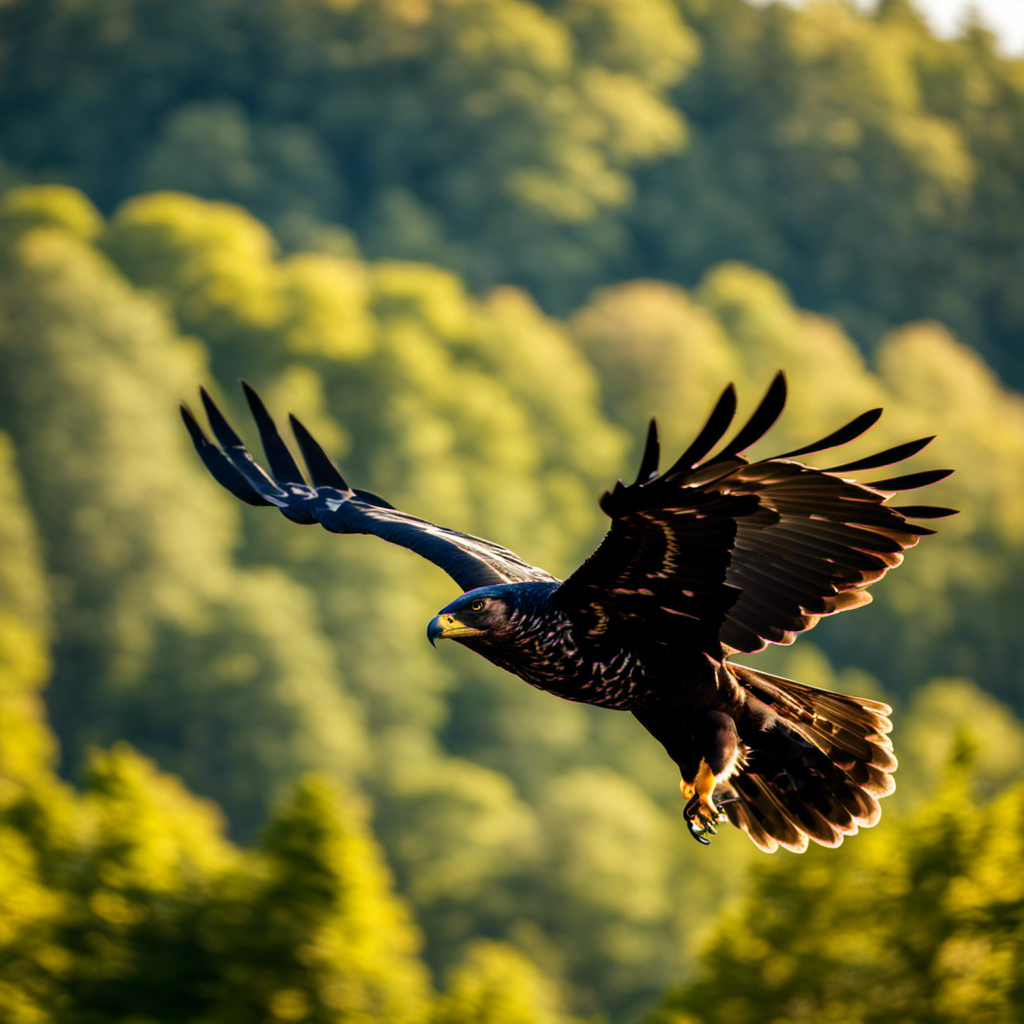
There are several unique features that make the Common black hawk a fascinating species to study. This hawk is primarily found in the southwestern United States and Central America, preferring habitats such as riparian areas, rivers, and canyons. Its distinctive black plumage and white tail bands make it easily identifiable.
When it comes to hunting behavior, the Common black hawk is known for its versatility. It has been observed hunting both on the wing and from perches. This hawk preys on a variety of small animals, such as fish, reptiles, and insects. Its sharp talons and powerful beak allow it to capture and consume its prey efficiently.
Great black hawk
Have you seen the Great black hawk soaring gracefully through the sky, effortlessly scanning the ground for its next meal? This magnificent bird, known scientifically as Buteogallus urubitinga, is native to the Americas and is most commonly found in tropical and subtropical regions.
Here are some key points to consider about the habitat and behavior of the great black hawk:
Habitat:
The great black hawk prefers coastal areas, mangroves, and wetlands.
They can also be found in savannas and forests near bodies of water.
In North America, they’re occasionally spotted in southern Texas and Florida.
Behavior:
Great black hawks are solitary birds, often seen perched on high branches.
They’ve a keen sense of sight and can spot prey from great distances.
Their diet consists mainly of small mammals, reptiles, amphibians, and large insects.
Conservation efforts for the great black hawk are crucial to ensure its survival. Efforts include:
- Protecting and preserving its habitat from urban development.
- Enforcing regulations against illegal hunting and trapping.
- Conducting research to better understand its population and migration patterns.
- Promoting awareness and education about the importance of conservation.
Roadside hawk
Spotting a Roadside hawk can be a thrilling experience, as they swoop down from high branches to catch their prey with precision and speed. Roadside hawks, scientifically known as Rupornis magnirostris, are found in various habitats across Central and South America. They’ve a preference for open areas such as grasslands, savannas, and agricultural fields. These hawks are often seen perched on telephone wires or tree branches alongside roads, hence their name.
Their breeding behavior is quite interesting. Roadside hawks typically form monogamous pairs and build nests in trees, using sticks and leaves. The female lays 2-3 eggs, which both parents take turns incubating for about 30 days. Once hatched, the chicks are fed by both parents until they fledge at around 6 weeks old.
Understanding the habitat preferences and breeding behavior of Roadside hawks is crucial for their conservation and management.
White-rumped hawk
You might spot a White-rumped hawk soaring high in the sky during your next birdwatching adventure in Pennsylvania. This species, scientifically known as Buteo leucorrhous, is an interesting subject of study due to its migration patterns and conservation efforts. Here are some key points to consider:
Migration Patterns:
White-rumped hawks are long-distance migrants, traveling from their breeding grounds in the north to wintering grounds in the south.
They undertake a remarkable journey, spanning thousands of miles, crossing various geographical barriers such as mountains and bodies of water.
These hawks usually migrate during daylight hours, taking advantage of favorable wind conditions to aid their flight.
Their migration routes often follow specific flyways, which are established pathways used by many bird species during migration.
Pennsylvania lies along the Atlantic Flyway, making it an important stopover location for these hawks during their migration.
Conservation Efforts:
White-rumped hawks face various threats, including habitat loss, pesticide use, and climate change.
Conservation organizations and researchers are working towards protecting their breeding and wintering habitats.
Preservation of key stopover sites and the establishment of protected areas are crucial for the survival of these hawks.
Monitoring their populations and studying their migration patterns help inform conservation strategies.
Public awareness and involvement in citizen science initiatives can contribute to the conservation efforts of the White-rumped hawk.
Understanding the migration patterns and conservation efforts of the White-rumped hawk is essential for ensuring the long-term survival of this magnificent species. By observing and learning about these hawks, you can contribute to our collective knowledge and help protect their habitats.
Black-collared hawk
If you’re interested in hawks, you might be amazed by the unique hunting techniques and striking appearance of the Black-collared hawk. Found in South America, this species is known for its distinct black collar and white belly.
The Black-collared hawk is a large bird of prey, measuring about 18 to 20 inches in length and weighing around 1.5 pounds. Its ecology and behavior are fascinating, as it primarily hunts fish by swooping down from perches near bodies of water.
This hawk is known to exhibit territorial behavior, defending its hunting grounds from other birds. Unfortunately, the conservation status of the Black-collared hawk is of concern, as habitat loss and pollution threaten its survival. Efforts are being made to protect its habitats and raise awareness about the importance of conservation.
Crane hawk
Have you ever observed the grace and agility of a crane hawk as it soars through the sky, effortlessly gliding on the wind currents? These magnificent birds, scientifically known as Geranospiza caerulescens, exhibit fascinating behavior and have distinct habitat preferences.
Here are some key aspects to consider about crane hawk behavior and habitat preferences:
Crane Hawk Behavior:
They’re known for their exceptional hunting skills, often preying on small mammals, reptiles, and amphibians.
Crane hawks are highly territorial and fiercely defend their nesting sites.
They’re skilled at maneuvering through dense vegetation, using their long legs and sharp talons to capture prey.
These hawks are known for their distinctive vocalizations, including high-pitched calls and piercing shrieks.
Crane hawks are opportunistic feeders, adapting their hunting techniques to the available food sources.
Crane Hawk Habitat Preferences:
They’re commonly found in tropical and subtropical regions, particularly in wetland areas such as marshes and swamps.
Crane hawks prefer habitats with dense vegetation for nesting and hunting.
They’re often spotted near water bodies, as they rely on aquatic prey for their diet.
These hawks are adaptable and can also be found in forested areas and savannahs.
Crane hawks are known to migrate seasonally, following food availability and temperature changes.
Understanding the behavior and habitat preferences of crane hawks is crucial for their conservation and management. By studying these magnificent birds, we can gain valuable insights into their ecological role and contribute to their long-term survival.
Tiny hawk
The tiny hawk may be small in size, but it’s known for its exceptional hunting skills and agility. Found in various regions, including North and South America, the tiny hawk is an intriguing species that warrants our attention.
Conservation efforts for this species are crucial, as their populations are declining due to habitat loss and fragmentation. Understanding the behavior of tiny hawks is essential in formulating effective conservation strategies.
These hawks are diurnal, meaning they’re active during the day, and they primarily feed on small vertebrates, such as lizards and birds. Their hunting techniques involve perching in trees, waiting for prey to pass by, and then swiftly diving down to catch it.
Frequently Asked Questions
What Are the Distinguishing Features of the Sharp-Shinned Hawk?
The distinguishing features of the sharp-shinned hawk include short, rounded wings, a long tail, and a small head. They prefer forested areas and can be found throughout North America.
How Does the Broad-Winged Hawk Differ From the Red-Shouldered Hawk?
The broad-winged hawk and red-shouldered hawk have noticeable differences. The former has a wider wingspan and a banded tail, while the latter has reddish shoulders and distinct markings on its belly. However, they both share similar hunting strategies and habitats.
What Is the Preferred Habitat of the Northern Goshawk?
The preferred habitat of the northern goshawk is characterized by dense forests with large trees, abundant prey, and minimal human disturbance. These habitat requirements ensure suitable nesting sites and ample food sources for this bird of prey.
Can You Provide Information on the Diet and Hunting Behavior of the Osprey?
The osprey, also known as the fish hawk, has a specialized diet primarily consisting of fish. It hunts by hovering over water and then diving feet-first to catch its prey with its sharp talons.
Are There Any Specific Conservation Efforts in Place for the Golden Eagle in Pennsylvania?
Conservation efforts for the golden eagle in Pennsylvania aim to protect and increase their population. Various initiatives focus on habitat preservation, reducing threats like habitat loss and collisions with structures, and raising public awareness about their importance in the ecosystem.
Are Ducks in Pennsylvania at Risk of Being Preyed upon by Hawks?
The safety of ducks in pennsylvania sightings may be compromised by the presence of hawks in the area. Hawks are known to prey upon smaller birds, posing a potential threat to the duck population. Locals and authorities should take necessary measures to ensure the protection and conservation of these delightful waterfowls.
Conclusion
In conclusion, Pennsylvania is home to a diverse range of hawk species including the Sharp-shinned hawk, Cooper’s hawk, Red-shouldered hawk, Broad-winged hawk, Red-tailed hawk, White-rumped hawk, Black-collared hawk, Crane hawk, and Tiny hawk.
These majestic birds of prey contribute to the ecological balance of the state by controlling rodent populations and serving as indicators of environmental health.
The presence of such a variety of hawks highlights the rich biodiversity of Pennsylvania’s habitats and emphasizes the importance of conservation efforts to protect these magnificent creatures.

An avid ornithologist, zoologist and biologist with an unwavering passion for birds and wild animals.
Dr. Wilson’s journey in ornithology began in childhood and led him to obtain a Ph.D. in Ornithology from the prestigious Avian Research Institute. He has worked closely with renowned experts in the field and conducted extensive research and field studies globally.
